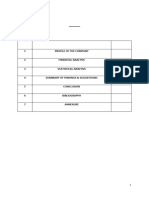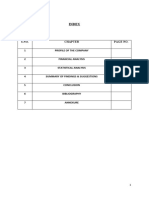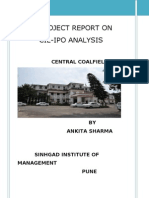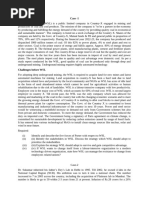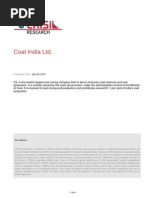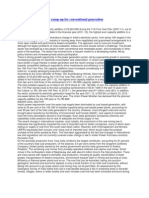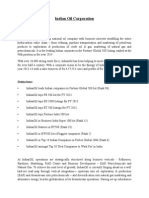India's Energy Scenario & Coal
India's Energy Scenario & Coal
Uploaded by
Chinmay ThakurCopyright:
Available Formats
India's Energy Scenario & Coal
India's Energy Scenario & Coal
Uploaded by
Chinmay ThakurOriginal Title
Copyright
Available Formats
Share this document
Did you find this document useful?
Is this content inappropriate?
Copyright:
Available Formats
India's Energy Scenario & Coal
India's Energy Scenario & Coal
Uploaded by
Chinmay ThakurCopyright:
Available Formats
Energy
Scenario
&
ng the top three fastest growing economies of the world. As a natural corollary India's energy needs too are fast expanding with its increased industrialization and capacity addition in Power generation. This is w input for major infrastructure industries like Power, Steel and Cement.
most dominant energy source in India's energy scenario.
s around 52% of primary commercial energy needs in India against 29% the world over.
% of India's power generation is coal based.
e 3rd largest coal producing country in the world after China and USA.
India
Limited
at
) as an organized state owned coal mining corporate came into being in November 1975 with the government taking over private coal mines. With a modest production of 79 Million Tonnes (MTs) at the year of its al producer in the world. Operating through 81 mining areas CIL is an apex body with 7 wholly owned coal producing subsidiaries and 1 mine planning and consultancy company spread over 8 provincial states ny in Mozambique christened as 'Coal India Africana Limitada'. CIL also manages 200 other establishments like workshops, hospitals etc. Further, it also owns 26 technical & management training institutes and 1 an Institute of Coal Management (IICM) as a state-of-the-art Management Training 'Centre of Excellence' - the largest Corporate Training Institute in India - operates under CIL and conducts multi disciplinary man
financial and other prerequisites was granted the Maharatna recognition in April 2011. It is a privileged status conferred by Government of India to select state owned enterprises in order to empower them to e as global giants. So far, the select club has only five members out of 217 Central Public Sector Enterprises in
Relevance
around 81.1% of India's overall coal production
here approximately 52% of primary commercial energy is coal dependent, CIL alone meets to the tune of 40% of primary commercial energy requirement
s nearly 74% of the Indian coal market
out of 86 coal based thermal power plants in India
or 76% of total thermal power generating capacity of the Utility sector
oal at prices discounted to international prices
ndian coal consumers against price volatility
end user industry globally competitive a key role
of
in
"India
Growth
Coal
Story"
and
making
India
India
incorporate
globally
Coal
India
Limited
is
to
produce
the
planned
quantity
of
coal,
and
efficiently
and
economically
with
due
Subsidiary
regard
to
safety,
conservatio
Structure
company with seven wholly owned coal producing subsidiary companies and one mine planning & consultancy company. It encompasses the whole gamut of identification of coal reserves, detailed exploration f timizing operations for coal extraction in its mines. The producing companies are:
alfields Limited (ECL), Sanctoria, West Bengal
king Coal Limited (BCCL), Dhanbad, Jharkhand
alfields Limited (CCL), Ranchi, Jharkhand
ern Coalfields Limited (SECL), Bilaspur, Chattisgarh
oalfields Limited (WCL), Nagpur, Maharashtra
Coalfields Limited (NCL), Singrauli, Madhya Pradesh
Coalfields Limtied (MCL), Sambalpur, Orissa
Africana Limitada, Mozambique
ltancy company is Central Mine Planning and Design Institute Limited (CMPDIL), Ranchi, Jharkhand. Coalfields major (NEC) consumers a are small Power coal and producing Steel unit sectors. operating Others in include Margherita, Cement, Assam is under Brick direct Kilns, operational and small
contr
Fertiliser,
secutive years CIL has bagged 'Excellent' rating in its Memorandum of Understanding (MoU) - a negotiated contract between Government and CIL Management - for performance evaluation on key physical an
and
on Tonnes of Coal annually. Coal production ending Financial Year 2011 was 431.32 Million Tonnes (MTs). CIL's dynamic production momentum is evident in the fact that in recent years, CIL leaped from 300 MTs m 008-09) in a time span of 5 years. It took CIL 12 years to cross the 300 MTs production mark from that of 200 MTs achieved in 1991-92. CIL Is targeted to produce 452 M
diary
companies
of
CIL
South
Eastern
Coalfields
Limited
and
Mahanadi
Coalfields
Limited
are
in
the
elite
club
of
100
MTs
coal
producing
companies
which
number
only
assets
ngly evident that domestic coal demand is far outstripping the indigenous production in India. The gap between demand and supply is ever expanding. Especially so in the wake of increased capacity addition coal
realistically CIL would not be able to satiate growing coal demand. Letters of Assurance (LoA) issued so far are already in excess of CIL's production. Present analysis indicate that there would be a shortage of 35 To meet this need coal import is
tself, in the interest of meeting the country's energy requirement, and is foraying into foreign shores for acquisition of coal properties. For the purpose CIL has adopted a three pronged approach. Acquisition of coa through equity participation with coal mining companies abroad and through long term coal off-t
es
d e-auction for selling coal to any consumer from any location in a transparent manner.
d Integrity Pact in High Value Procurement.
ment introduced for speeding up purchase of vital inputs
SR
structured CSR policy around coal mining areas to improve quality of life with community consensus and inclusive participation
pensaries and wellness clinics introduced on a large scale.
cine facilities introduced in central hospitals.
medical services to employees, their families and local populace through 86 fully equipped hospitals having 5835 beds.
524 specialist Doctors.
dispensaries and has 640 Ambulances.
otable water to about 2.3 million populace in remote corners of CIL's areas of operation
36 schools under different categories - Project Schools (55); Privately managed Schools with grant packages (284); Private Committee Managed Educational Institutes (72) and other schools where occasional grant
d 'Coal India Scholarships' for 100 Below Poverty Line students plus 25 wards of land losers in government engineering and medical colleges. Scholarship covers education, hostel and mess charges
entire cost of wards of workmen securing admission in government engineering and medical colleges
d to generate employment opportunities for people in mining areas by providing vocational training.
any Pursues 'Mining with a human face' through socially sustainable inclusive model of growth by making Project Affected People stakeholders in the decision making process for their livelihood.
cilities extended to nearby communities in fully equipped company hospitals.
pensaries and Tele-medicine facilities meant for employees also extended to nearby village populace.
(Figure
for
ndencies of coal mining is degradation of the land and environment. CIL constantly addresses the impact of mining activities across environmental and social issues. Eco-friendly mining systems have been put in p environmental mitigation measures more transparent, CIL introduced state-of-the-art Satellite Surveillance to monitor land reclamation and restoration for all
fforestation over an area of around 32,000 Hectares while the total forest area degraded due to mining operation is around 12,800 Hectares, which means, for every hectare of forest land degraded, CIL has of the & adverse Green' impact programme, of coal mining plantation on has environment been taken through up by well CIL structured wherever Environment land is Management CIL has Plans till and date sustainable planted over
minimize 'Clean
deve
massive
available.
effort towards improvement of environment through massive plantation undertaken in Singrauli Coalfields since 1985, is such that the analysis for the period 1985-1995 and 1996-2002 carried out by Conservator
maximum
temperature
in
Singrauli
has
decreased
by
0.4oC
while
the
annual
average
rainy
days
increased
by
11.2
days
and
average
annual
rainfall
has
increase
tion of Environment Management System (ISO:14001) with Quality Management System (ISO:9001) and till date have successfully achieved certification of 53 of its projects. This integration is being extended to all
You might also like
- Economics Project: Coal India LTDDocument27 pagesEconomics Project: Coal India LTDYash SinghaniaNo ratings yet
- Coal India Limited: CDSCRCDocument5 pagesCoal India Limited: CDSCRCsanchu1981No ratings yet
- Coal India LTGDocument85 pagesCoal India LTGpraveen182718No ratings yet
- Coal IndiaDocument83 pagesCoal IndiaHarsh MishraNo ratings yet
- Coal India Financial AnalysisDocument30 pagesCoal India Financial AnalysisKanad JoshiNo ratings yet
- Weelfare Measure PracticeDocument22 pagesWeelfare Measure Practiceluek942No ratings yet
- Looking Beyond CoalDocument13 pagesLooking Beyond CoalVats RajNo ratings yet
- A Project Report On Cil-Ipo Analysis: Central Coalfields LimitedDocument71 pagesA Project Report On Cil-Ipo Analysis: Central Coalfields LimitedAnkita SharmaNo ratings yet
- Public SectorDocument20 pagesPublic SectorHarsh KothariNo ratings yet
- AssignmentDocument2 pagesAssignmentrajatyadav1445No ratings yet
- Eco SC Form Project 1Document11 pagesEco SC Form Project 1Anuj AgarwalNo ratings yet
- Capital Budgeting and Proj Costing at CMPDIDocument36 pagesCapital Budgeting and Proj Costing at CMPDIShreeti PrabhaNo ratings yet
- HR Project On Employee Welfare and MeasuresDocument50 pagesHR Project On Employee Welfare and Measuresbalaji bysani74% (19)
- Case 3: Gloom To Glory: The Successful Turnaround of The Singareni Collieries Company LimitedDocument22 pagesCase 3: Gloom To Glory: The Successful Turnaround of The Singareni Collieries Company LimitedDhivyashene RajaendranNo ratings yet
- Coal India LimitedDocument92 pagesCoal India LimitedChanchal K Kumar100% (3)
- Coal India LTD.: Published DateDocument4 pagesCoal India LTD.: Published DatePragyanDasNo ratings yet
- Coal India Limited: Anamika Ray Reg - No. 09CQCMA005Document12 pagesCoal India Limited: Anamika Ray Reg - No. 09CQCMA005Shashi DharNo ratings yet
- KRC Weekender 29aug07Document4 pagesKRC Weekender 29aug07rneelagundNo ratings yet
- Captive-Coal 1248433300265Document8 pagesCaptive-Coal 1248433300265Veneet VishalNo ratings yet
- Privatization of Coal Mines in IndiaDocument2 pagesPrivatization of Coal Mines in IndiaJust ChillNo ratings yet
- Presentation On Training & DevelopmentDocument66 pagesPresentation On Training & DevelopmentRagini Mishra50% (2)
- Adani 1Document3 pagesAdani 1Puneeta RaniNo ratings yet
- Industry AnalysisDocument15 pagesIndustry AnalysisRajagopalan GanesanNo ratings yet
- Power Center Capacity Ramp-Up For Conventional GenerationDocument4 pagesPower Center Capacity Ramp-Up For Conventional GenerationHarshPanugantiNo ratings yet
- Power Sector in India: National Thermal Power Corporation NHPCDocument6 pagesPower Sector in India: National Thermal Power Corporation NHPCDivya ParvathaneniNo ratings yet
- Garv Chawla Research PaperDocument12 pagesGarv Chawla Research Papergarvchawla2310No ratings yet
- First Revised Karnataka R.E.policy DraftDocument23 pagesFirst Revised Karnataka R.E.policy DraftGuru VagaNo ratings yet
- Metis Coal Report Brochure Full May 1Document8 pagesMetis Coal Report Brochure Full May 1arorakgarima100% (1)
- Energy Security & EILDocument3 pagesEnergy Security & EILAmanpreet SinghNo ratings yet
- WWW - MINEPORTAL.in: Online Test Series ForDocument16 pagesWWW - MINEPORTAL.in: Online Test Series ForAjeet KumarNo ratings yet
- Chap 8 Annual Report 2022 enDocument22 pagesChap 8 Annual Report 2022 enBharat MalikNo ratings yet
- CS As Corporate Saviour - Oil and Gas IndustryDocument27 pagesCS As Corporate Saviour - Oil and Gas IndustrycelebalworkNo ratings yet
- Phasing Out Coal in India Rationale and Challenges - Explained PointwiseDocument6 pagesPhasing Out Coal in India Rationale and Challenges - Explained Pointwiseknrs4u8921No ratings yet
- "Central Coalfields Limited": Topic: - "Workers' Participation in Management"Document21 pages"Central Coalfields Limited": Topic: - "Workers' Participation in Management"abhilashNo ratings yet
- Gist of EPW September Week 1, 2019: 1. Foreign Investment in Coal MiningDocument33 pagesGist of EPW September Week 1, 2019: 1. Foreign Investment in Coal Miningvijay gargiNo ratings yet
- Coal Trading in IndiaDocument7 pagesCoal Trading in IndiakiritiguharoyNo ratings yet
- Coal India Investor BriefDocument8 pagesCoal India Investor BriefhhhhhhhuuuuuyyuyyyyyNo ratings yet
- Coal India Company Profile and Its AnalysisDocument14 pagesCoal India Company Profile and Its AnalysisMithunNo ratings yet
- Project On Industrial Analysis: Energy Sector: BY: Abhishek Kumar Sinha Kumari Priya Shreel Dwivedi Anwesha ChatterjeeDocument12 pagesProject On Industrial Analysis: Energy Sector: BY: Abhishek Kumar Sinha Kumari Priya Shreel Dwivedi Anwesha ChatterjeesibbipriyaNo ratings yet
- Means For Improvement of Production and Productivity in Indian Coal Mines - A Case StudyDocument12 pagesMeans For Improvement of Production and Productivity in Indian Coal Mines - A Case StudySatya LearnerNo ratings yet
- Functional Strategy and Its AlignmentDocument7 pagesFunctional Strategy and Its AlignmentDebasishNo ratings yet
- Coal India IPODocument14 pagesCoal India IPOpurswaniNo ratings yet
- CP March 21Document28 pagesCP March 21harrry9471No ratings yet
- Presented by Bhakti Bhusan Parida Roll-16Document17 pagesPresented by Bhakti Bhusan Parida Roll-16bb2No ratings yet
- Organisational Study Report On NALCODocument35 pagesOrganisational Study Report On NALCORohan Kumar TripathyNo ratings yet
- Oversees Coal in IndiaDocument13 pagesOversees Coal in IndiaNaman RawatNo ratings yet
- Project Work On:-: Installation of Solar Plant-Feasibility Study For HouseholdsDocument55 pagesProject Work On:-: Installation of Solar Plant-Feasibility Study For Householdsvicky mehtaNo ratings yet
- Energy Sector of PakistanDocument8 pagesEnergy Sector of PakistanShakir MohyuddinNo ratings yet
- Executive SummaryDocument3 pagesExecutive SummaryVijay BawejaNo ratings yet
- Profile of Chairman: SitemapDocument5 pagesProfile of Chairman: SitemaphellotoyashNo ratings yet
- AgricultureDocument20 pagesAgricultureAmit NaikNo ratings yet
- Energy Security in IndiaDocument23 pagesEnergy Security in IndiaSinyen ChoirNo ratings yet
- ADANI PowerDocument6 pagesADANI Powerkitrak89No ratings yet
- National Thermal Power CooperationDocument20 pagesNational Thermal Power CooperationMukesh ManwaniNo ratings yet
- Major Project On TataDocument64 pagesMajor Project On TataRohitNo ratings yet
- Indian Oil CorporationDocument41 pagesIndian Oil CorporationTage NobinNo ratings yet
- Hydrogen: A renewable energy perspectiveFrom EverandHydrogen: A renewable energy perspectiveNo ratings yet
- Innovation Outlook: Renewable MethanolFrom EverandInnovation Outlook: Renewable MethanolNo ratings yet



